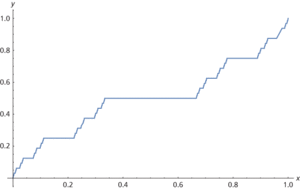The Cantor function C:[0,1]→[0,1] is an example of a continuous cumulative distribution function which has no probability density function. To define C, we write x∈[0,1] in ternary. If x’s expansion includes the digit 1, then all digits after the first 1 are made 0; any 2s are then made into 1s, and C(x) is this expansion, evaluated in binary. For example, any x in the range 7/9 < x < 8/9 has expansion x = 0.21…3 and so C(x) = 0.112 = 3/4. See the sketch. The graph of C is sometimes called the Devil’s Staircase.
C is continuous everywhere and differentiable almost everywhere with derivative 0. In fact, C is not differentiable only on the Cantor set, which is a null set. So any pdf would be 0 almost everywhere, and hence no pdf exists. Note that This does not contradict the Fundamental Theorem of Calculus, as C′ is not continuous. C is uniformly continuous but is not absolutely continuous.

The Devil’s Staircase, the cdf of the Cantor distribution
- optical wedge
- optic axis
- optic chiasm
- optic lobes
- optic nerve
- optics
- optic vesicle
- optimal
- optimal binary search tree
- optimal control
- optimal foraging theory
- optimal growth theory
- optimality condition
- optimal level of pollution
- optimal strategy
- optimal taxation
- optimific
- optimism and pessimism
- optimism index
- optimization
- optimization model
- optimizer
- optimum allocation
- optimum currency area
- optimum interpolation